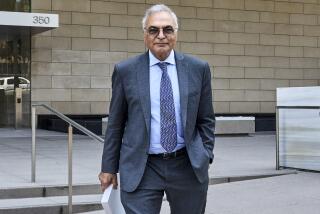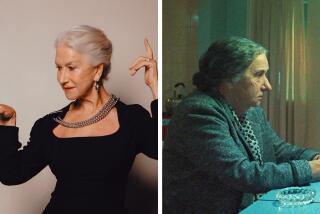Body Shop : Hollywood Lends Surgeons Helping Hand
- Share via
CANOGA PARK — Flanked by the severed heads and drooling monsters he created for movies such as “Aliens” and “Slumber Party Massacre,” Rick Lazzarini seems an unlikely pioneer for the health sciences.
One might hardly expect the man behind television’s Foster Farms chickens and Duracell boxers to know much about the human pancreas or bile duct.
But with techniques honed for Hollywood, the puppeteer and special effects wizard has crafted a set of lifelike organs to help train surgeons for the new art of endoscopic surgery. Moviegoers may recoil from cinematic gore, but surgeons love his gallbladder.
Practice with Lazzarini’s unique, silicone rubber hernia model or uterus, surgeons say, could help dramatically lower the number of botched jobs that have plagued early endoscopy.
The reusable innards also could reduce the number of live pigs or expensive cadavers sliced open for training.
“Surgeons have been searching for models to work on forever,” said Dr. Robert Gordon of EndoCare, a West Los Angeles-based surgery center that developed the models with Lazzarini. “This is the closest you can get to the real thing without a beating heart and an anesthesiologist yelling at you.”
The use of endoscopes--tiny video cameras and surgical tools inserted into the patient at the end of thin tubes--revolutionized surgery during the late 1980s. The new technique meant shorter hospital stays and smaller scars for patients needing relatively minor operations.
But the procedure required surgeons nationwide to trade scalpels for a whole new set of tools and watch their movements on a video screen instead of directly in the patient.
As surgeons quickly tried to learn the tricky, Nintendo-like methods of removing gallbladders, treating hernias and diagnosing stomach, lung and eye problems, mistakes were made.
“It was the largest post-graduate training effort ever attempted,” Dr. Edward H. Phillips, director of endoscopic surgery at Cedars-Sinai Medical Center, said of the switch to the new method. “There was simply no precedent or systems to train the 20,000 to 25,000 surgeons who wanted to learn the technique right away.”
Some older and less-nimble surgeons had trouble adapting. In 1992, New York hospital data revealed a rise in injuries to gallbladder patients since laparoscopic surgery--endoscopic surgery performed through the abdomen--became a popular method of treatment.
It was clear the surgeons needed practice. The demand for practice subjects became a boon for U. S. pig farmers, who suddenly found hospitals a market for thousands of their animals, whose gastrointestinal systems are similar to those of humans.
But pig parts wear out. Gordon said he and EndoCare Director Stephen Shapiro had built a box in 1990 to simulate the human frame, but were “frantic” to find materials that resembled human tissue to put inside. They tried broccoli spears. Too soft. They tried elbow macaroni. It ripped too easily.
Finally, Gordon said, the EndoCare office manager, tired of grocery shopping one item at a time, pointed out the office window toward the nearby Fox Studios building.
“She said, ‘Look over there. If they can make aliens fly out of Sigourney Weaver’s chest, they can probably make you a gallbladder,’ ” Gordon said. “So we made a few calls and married the two great industries of medicine and Hollywood.”
At his Canoga Park studio, The Character Shop, Lazzarini demonstrated one of his newest inventions, peeling back the silicone skin from a face model that may soon be on the market for simulated plastic surgery and face-lifts. On a table next to him sat a model of a knee with an authentic bone structure.
Although neither is fully developed, Lazzarini said, they represent the mushrooming possibilities for endoscopic surgery. So far, The Character Shop is believed to be the only company in the nation making such models.
For now, he keeps several staff artists busy molding and painting models of the uterus, gallbladder and hernia for dozens of orders from hospitals and practitioners in the United States and Europe.
They work alongside others creating mechanical horses, elephant heads and ghoulish masks for upcoming films and TV ads.
“There’s kind of an irony there,” Lazzarini said. “On one film, we might be spilling someone’s intestines out, but the next week the same person could be working on a model with the viscera intact.”
Creatures for the movies must look real from the outside, but when designing surgery models, Lazzarini has focused on making the human parts seem authentic on the inside.
For surgeons, texture counts. Each organ has a different feel against the tug of surgical graspers, cutting tools and staplers. Lazzarini’s bile duct has received the most praise.
“When you put your endoscope inside that model, it really looks like the real thing,” said Phillips of Cedars-Sinai. “It absolutely replaces the need to use animals.”
To research the look and feel of human organs, Lazzarini thumbed volumes of surgery photos. Then he scrubbed down, donned a surgical mask and witnessed operations at EndoCare.
“After so many years making blood spurt out of bodies and flying heads, it was weird,” Lazzarini said. “When I saw the real thing, I had to look away.”
More to Read
Inside the business of entertainment
The Wide Shot brings you news, analysis and insights on everything from streaming wars to production — and what it all means for the future.
You may occasionally receive promotional content from the Los Angeles Times.










